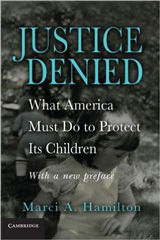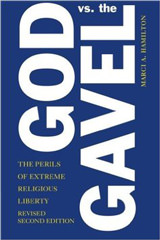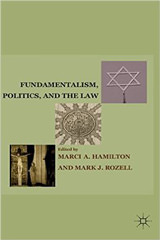Long before the Supreme Court held that same-sex couples have a fundamental right to marry in Obergefell v. Hodges, those groups and believers that oppose same-sex marriage were busy lobbying for state legislation and drafting federal legislation to protect themselves from negative consequences if they were to impose their beliefs against same-sex couples. In short, they knew that they were facing the end of an era.
Just shy of 50 years before Obergefell, the Supreme Court held that interracial couples have the same fundamental right to marry in Loving v. Virginia. That decision was greeted with less enthusiasm than Obergefell, as only a small percentage, approximately 20 percent, of Americans supported a right to interracial marriage. In contrast, 42 percent of Americans support same sex marriage—more than double the support for interracial marriage immediately after Loving. (In addition, if you drill down by age, the younger the person, the higher the percentage support for same-sex marriage.)
Thus, believers in what they call “traditional marriage” had realistic premonitions that their desire to keep same-sex marriage at bay in their universes would be challenged. Some states, but far from all, passed a variety of legislation (or in the case of Louisiana, Gov. Jindal pushed into place an executive order) defensively preparing for the Court’s inevitable decision in favor of same-sex marriage. Now some conservative members of Congress have stepped in.
The So-Called First Amendment Defense Act
Enter the unfortunately and misleadingly named federal First Amendment Defense Act (“FADA”). FADA is a bill that would protect individuals, nonprofit, and for-profit organizations that have a “religious belief or moral conviction that marriage is or should be recognized as the union of one man and one woman, or that sexual relations are properly reserved to such a marriage.” Think of it as a giant dome above the believers who oppose same-sex marriage that keeps the rule of law at bay.
It is decidedly not a replication of the First Amendment and in fact would be more accurately named the “Unconstitutional Under the First Amendment Act,” as I explain below.
The Background: RFRA to FADA
FADA is being touted as a “religious liberty” bill like the Religious Freedom Restoration Act (“RFRA”), but it is not.
RFRA is a deeply misguided law that instituted sui generis super statutory protection for believers against all laws by imposing a standard on the government that was not part of the First Amendment free exercise cases. Early on, its defenders claimed it just “restored” First Amendment freedoms à la its title, but the Supreme Court has repeatedly confirmed, most recently in Burwell v. Hobby Lobby, that RFRA’s extreme standard is statutory, not constitutional.
RFRA has this feel-good name and exterior and trades on the ignorance of Americans (including most legislators) about the actual standards, i.e., technical legal language, imposed under the First Amendment. It was sold with support by religion and law scholars, and supported by a wide coalition, liberal to conservative. But that was twenty years ago, and as the truth of its extreme content came to the surface, the coalition dissolved.
Despite its inviting exterior, RFRA is a black box of unintended consequences that has invited believers to think of “religious liberty” as a right to impose one’s faith on others. The Hobby Lobby decision is just the most famous application of it as the arts and crafts behemoth obtained the right to exclude coverage of certain contraceptives from its employees’ health plans. In other words, it was good news for conservative Christians with an agenda against contraception, but bad news for female employees whose coverage was put at risk (until the federal government extended the accommodation for non-profits to for-profit companies). In other words, RFRA is a benefit-cost statute—believers benefit while everyone else pays.
The LGBTQ community has been the target and the victim of much of the most recent RFRA activity as the federal model was imported into many states, with a number of states making it even more extreme. The more it has evolved, the less lovely it has appeared.
One of RFRA’s chief defects is that it has created a privileged class that can wield their faith as a sword against others. RFRA’s other chief defect is that it transforms judges into super-legislators by requiring them to consider whether the law being challenged is the “least restrictive means” of achieving the government’s compelling interest for this believer. Courts have embraced this new power with gusto, throwing to the wind the respectful deference of the other branches that was a part of the First Amendment’s free exercise cases. Federal courts now know more than Congress and the President about contraception, more than prison authorities about measures for prison safety involving beard length and hidden contraband and more than the armed forces about military headgear. These RFRA cases in effect reversed the First Amendment decisions in O’Lone v. Estate of Shabazz and Goldman v. Weinberger with nary a nod to the other branches. This is just judicial activism pure and simple.
FADA shares neither RFRA’s universality nor its super strict scrutiny. Rather, FADA would only be good for one set of beliefs, and would replace super strict scrutiny with absolute rights.
How FADA Would Work
FADA creates absolute rights for same-sex marriage opponents. First, there is money. Say a nonprofit runs a soup kitchen and believes that only heterosexuals should marry and have children. If that soup kitchen refuses to feed same-sex couples and families, FADA prohibits the federal government from altering its tax status, disallowing donors’ tax deductions, withholding government funds for soup kitchens, or otherwise diminishing any benefit.
Second, there is accreditation or licensing. Same scenario with a nonprofit soup kitchen turning away same-sex couples and families. The entity can’t lose its accreditation or license for acting in accordance with its beliefs, even if in opposition to the civil rights of the couples and families.
Third, and here is where FADA shares some features of RFRA: (1) the discriminating entity is given a private right of action; (2) the Department of Justice is charged with enforcing this pro-discrimination law against the federal government; (3) the government can be required to pay the discriminating entity’s attorneys fees; and (4) in case a federal court would use common sense and judgment in interpreting the act to find a balance between all those affected, FADA exhorts the courts to interpret it in favor of the believer to the “maximum extent.”
Fourth, unlike RFRA (and its counterpart RLUIPA), under FADA, the discriminating entity need not satisfy any administrative remedies before rushing to federal court.
Finally, and FADA holds this element to the very last line: FADA’s absolute rights can be invoked by not only religious and nonprofit entities, but also by for-profit companies. Therefore, Hobby Lobby could choose not to hire any same-sex couples or to discriminate against them on the basis of wages and benefits.
Constitutionality
FADA’s optics are unlike RFRA where members of Congress could hide behind the generic “Religious Freedom Restoration Act” and tout “religious liberty” for everyone without having to ask, know, or care about specific applications of the law. Here, the applications are crystal clear and they are limited to one belief.
To put it into constitutional jargon: FADA is content-based and viewpoint-based. Viewpoint-based laws are subjected to the strictest of scrutiny and presumptively unconstitutional under the First Amendment. FADA’s defenders I assume will argue that it is just another religious accommodation, like the tax-exempt status of religious entities or the exemption for the Native American Church to use peyote. But it isn’t.
It is not like tax exemptions; those are defensible because the federal tax code treats religious and non-religious nonprofits alike. And it is not like the Native American Church exemption for peyote, because that is justified by the federal government on the ground that Native American churches get special treatment due to the separate sovereignty of Native American tribes. Moreover, what is protected by FADA is financial status, not religious observance. Can any of those entities that would choose to embrace FADA credibly argue that receiving federal funds is required by their religious faith? The irony is that for many of the conservative religious organizations opposed to same-sex marriage, there was a time when they eschewed federal funding because it would interfere with their autonomy. Now that they are dependent on federal funds, they have proven their own point.
FADA’s Opponents Should Pay Attention on July 30 to Ensure That the Sneaky Enactment of RFRA in 2000 Does Not Repeat Itself
After RFRA was held unconstitutional in 1997, its supporters lobbied for RFRA II (entitled the Religious Freedom Protection Act). By then, RFRA’s folly was apparent at least to the civil rights, child protection, and land use planning community, so it faced tough going.
Never underestimate the will of legislators pandering to religious entities, however. During the summer of 2000, RFRA’s re-enactment was considered unlikely and hearings were promised for its opponents in September 2000. While RFRA’s opponents left town for the 2000 summer recess, its proponents enacted it in both houses of Congress via “unanimous consent,” i.e., with barely a handful present in each house. Dirty tricks, of course, are a congressional specialty, so no one should be terribly surprised. But RFRA’s opponents were!
FADA has not been an immediate hit across Capitol Hill, so its fate may appear to be unclear, with its sponsors saying they will let it go for now and return to it in September. (Sound familiar?) The conservative Christians who lobbied so hard for the RFRA of 1993 and 2000 (in part to discriminate in housing against LGBTQs), are still in the picture and surely have fond memories of their 2000 coup.
This year, the House goes into recess starting the evening of July 30, and the Senate the evening of August 7. If I were the groups that are lobbying against FADA, e.g., the civil rights and “Nones” groups, I would strongly consider posting folks in the House on July 30 for the entire day. And then again right before the Senate goes out on August 7. Fooled you once, shame on them. Fooled you twice, shame on you.
The Countermoves to Guard Against Discrimination
Unlike RFRA, FADA is not being proposed in a vacuum or echo chamber where the believer is the sole focus. Instead, there is a context: the ones who could be hurt by the believer are clearly identified. To this end, there are two recent developments that protect LGBTQ individuals against discrimination. First, the EEOC ruled that sexual orientation is a category protected under “gender” in civil rights cases. This means the EEOC will be able to file lawsuits against those who discriminate against LGBTQ individuals.
Second, FADA will soon have to compete with the Equality Act, which takes the opposite position and would prohibit discrimination on the basis of sexual orientation in the context of public accommodations, public education, employment, housing, federal funding, jury service, legal protections, and credit.
These developments show FADA for what it is, and it is not a benevolent system to help the needy or the poor. Rather, it is an extreme “religious liberty” bill that violates civil rights. Perhaps Congress can approach it without the mindless feel-good spirit that RFRA engendered as late as 2000. Even more loftily, maybe we can finally think of returning to the actual First Amendment for authentic religious freedom. There has to be a public space where faith cannot be used as a weapon to hurt others.










Religious exemptions to some extent are justified since “free exercise” involves some specific exceptions to rules that something else might not justify. The 1A singles out religion in that respect. But, it is only one part of the equation, especially when harms to third parties are involved.
Sez the prof: “These RFRA cases in effect reversed the First Amendment decisions in O’Lone v. Estate of Shabazz and Goldman v. Weinberger with nary a nod to the other branches. This is just judicial activism pure and simple.”
“Nary a nod?” Really? I can’t speak to Estate of Shabazz (haven’t read it; don’t plan to) but I was on active duty when Goldman came out and followed it. No, at least as to Goldberg, it’s more like a law professor not knowing either the law or the history of a disputed point.
See 121 Mil. L. Rev. 125 (1988), “The Congressional Response to Goldman V. Weinberger,” by 1Lt Dwight H. Sullivan, available at:
http://www.loc.gov/rr/frd/Military_Law/Military_Law_Review/pdf-files/275075~1.pdf
Second, how Congress reacted to Goldman is a model of how civilians are supposed to interact with the military it funds (wholly) and controls (in part; make regulations for land and naval forces). The FY 1985 Department of Defense Authorization Bill fired a fairly gentle warning softball shot across the bow of the Services. Their Study Group did not take enough of a hint, so Congress came back with direction in FY 88 . . . and Ronald Reagan signed it. Adult leadership out of of Congress. Whoda thunk it. Maybe we’ll see its like again?
See also 10 U.S.C. § 774 : US Code – Section 774: Religious apparel: wearing while in uniform.
(a) General Rule.— Except as provided under subsection (b), a member of the armed forces may wear an item of religious apparel while wearing the uniform of the member’s armed force.
(b) Exceptions.— The Secretary concerned may prohibit the wearing of an item of religious apparel—
(1) in circumstances with respect to which the Secretary determines that the wearing of the item would interfere with the performance of the member’s military duties; or
(2) if the Secretary determines, under regulations under subsection (c), that the item of apparel is not neat and conservative.
(c) Regulations.— The Secretary concerned shall prescribe regulations concerning the wearing of religious apparel by members of the armed forces under the Secretary’s jurisdiction while the members are wearing the uniform. Such regulations shall be consistent with subsections (a) and (b).
(d) Religious Apparel Defined.— In this section, the term “religious apparel” means apparel the wearing of which is part of the observance of the religious faith practiced by the member.
http://www.law.cornell.edu/uscode/text/10/774
Source:
http://www.law.cornell.edu/uscode/text/10/774?qt-us_code_tabs=1#qt-us_code_tabs
(Added by Pub. L. 100–180, div. A, title V, § 508(a)(2), Dec. 4, 1987, 101 Stat. 1086.)
Pub. L. 100–180, div. A, title V, § 508(c), Dec. 4, 1987, 101 Stat. 1087, directed the Secretary concerned to prescribe the regulations required by subsec. (c) of this section not later than the end of the 120-day period beginning on Dec. 4, 1987.
“It is not like tax exemptions; those are defensible because the federal tax code treats religious and non-religious nonprofits alike.”
But it doesn’t. http://1.usa.gov/1E5WwCX